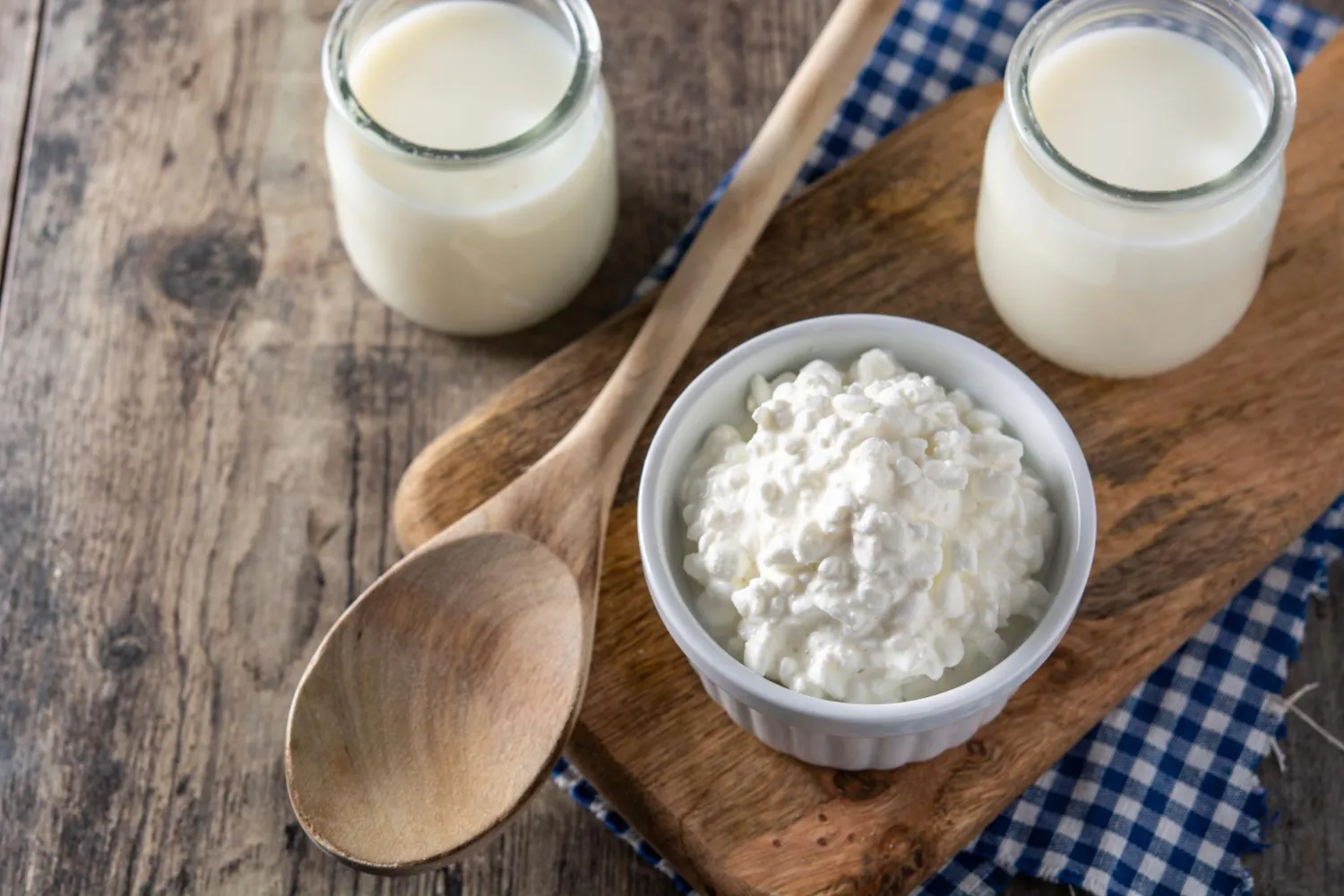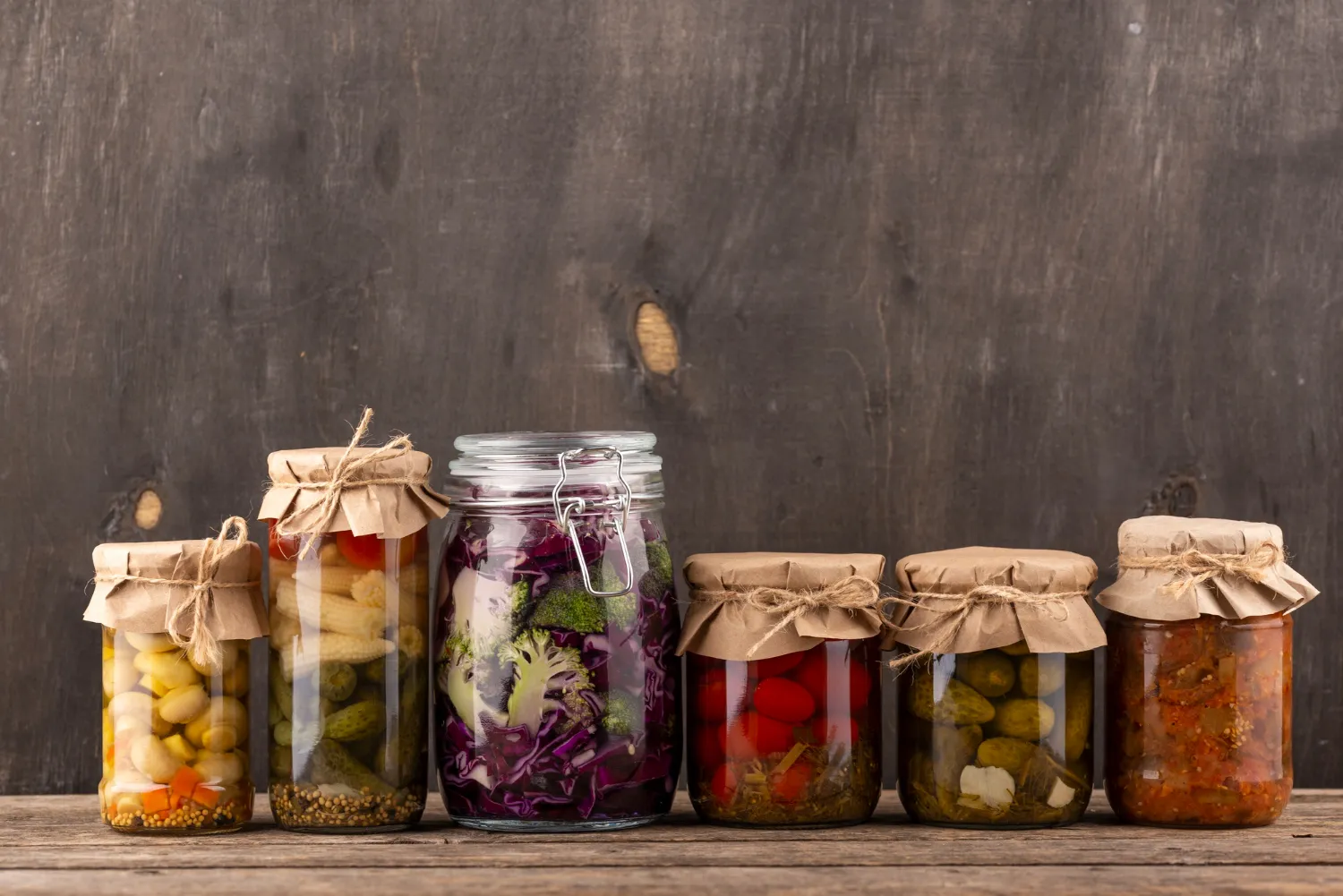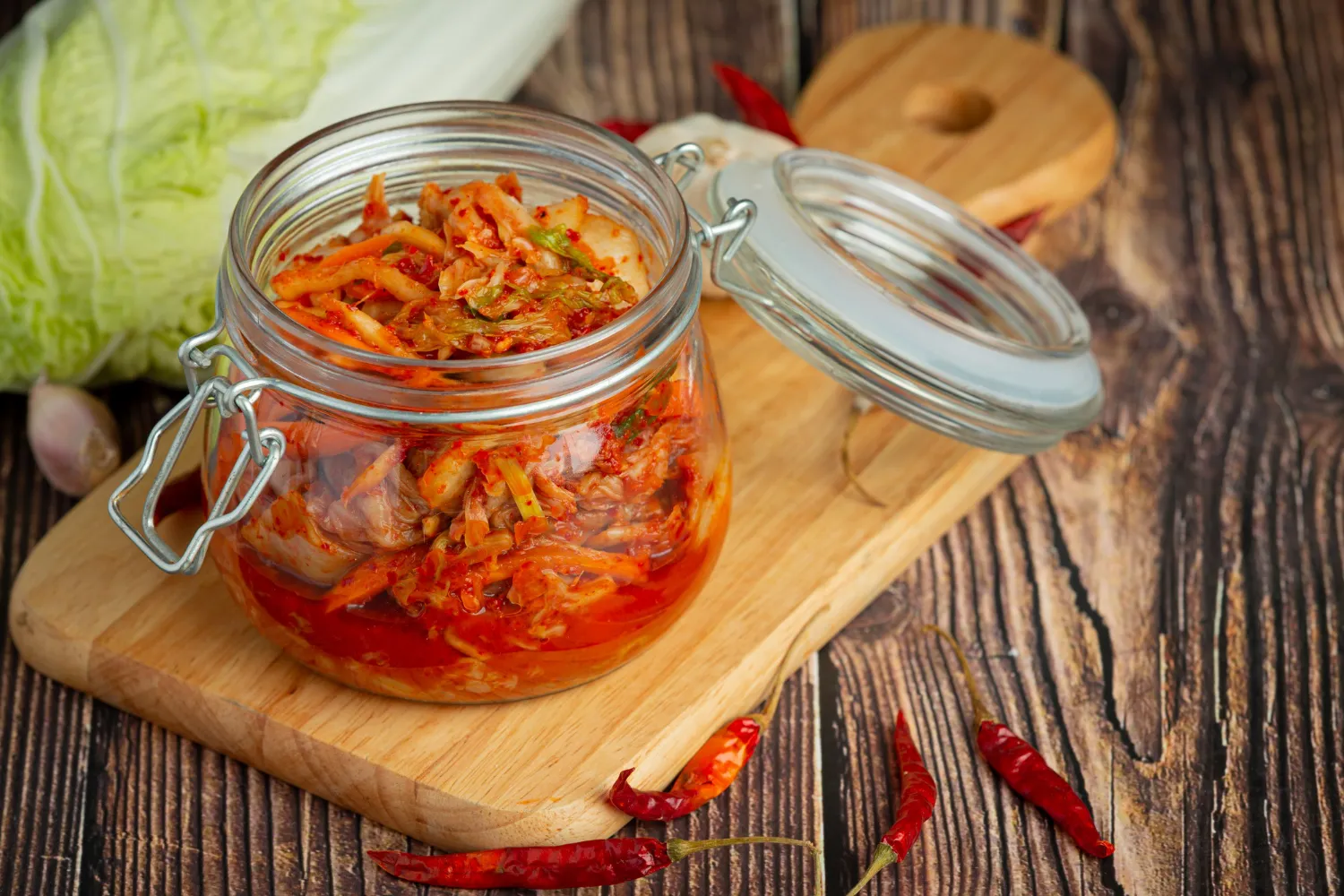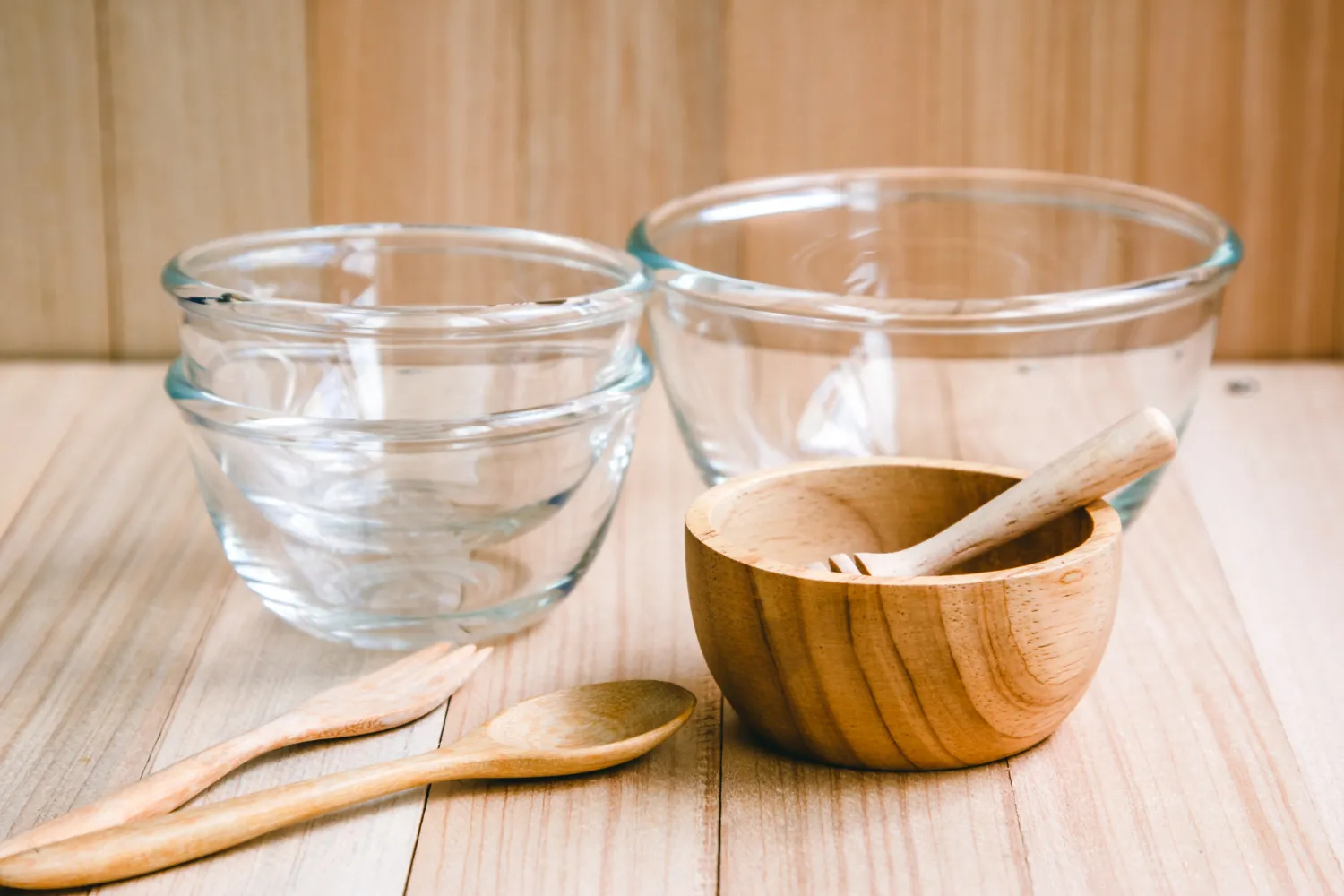Nourishing Your Gut
Fermentation Alchemy for Self-Care

[Toc]
With its bubbles and tang, fermentation brings a touch of lightheartedness to the kitchen. The first time I opened a jar of homemade kimchi, the effervescence danced out of the container filling the house with a pungent smell. It's a reminder that the process of fermentation is alive, just like the beneficial microorganisms within.
This post embraces fermentation quirks—whether it's the fizziness of kombucha or the funky smell of miso. Laughter and a light-hearted approach can turn any kitchen experiment into an adventure. So, let's raise a fork to the quirks of fermentation and the health and joy they add to our culinary escapades.
What are Fermented Foods?
Fermented foods are the timeless alchemists of the culinary world, weaving magic through the art of preservation. Their journey begins with the orchestration of microorganisms—tiny maestros including bacteria, yeast, and molds. Together, they embark on a symphony of transformation, turning raw ingredients into something utterly new, rich, and complex.
Picture sauerkraut, a humble cabbage undergoing a metamorphosis within the confines of a jar, its effervescence capturing the essence of fermentation. Imagine the lively dance of flavors in kimchi, each bite resonating with a tangy zest that tells the story of its fermentation journey.
Beyond the enchantment of taste, this transformative process transcends the merely gustatory. It's a meta magic that elevates not just the culinary experience but also our well-being.

The Gut-Connection for Women Over 45
For women over 45, the gut takes center stage in the theater of well-being. The gut microbiome, a community of trillions of microorganisms residing in our digestive tract, plays a crucial role in nutrient absorption and immune function. As we age, maintaining a balanced gut becomes paramount.
Fermented foods emerge as unsung heroes, providing a powerful arsenal of probiotics—friendly bacteria that aid digestion and promote gut health. Incorporating these foods into our diet becomes an act of self-care, supporting not just digestion but also overall well-being.

List of Fermented Foods
Fermentation can be witnessed in various foods, from dairy (yogurt) to vegetables (pickles), and even in beverages like kombucha.
Sauerkraut, a classic, not only tickles the taste buds but also aids digestion with its probiotic content. This humble concoction of fermented cabbage is teeming with lactobacilli, friendly bacteria that not only contribute to its tangy flavor but also play a crucial role in promoting a healthy gut. So, with each crisp and tangy forkful, you're not just savoring tradition; you're nurturing a community of beneficial microorganisms within.
Kimchi, a staple in Korean cuisine, brings a spicy kick along with beneficial bacteria. This vibrant concoction, primarily crafted from fermented napa cabbage, radishes, and a melange of spices, not only tantalizes the taste buds but also introduces a burst of probiotics into your digestive realm.
Yogurt, a breakfast favorite, provides a creamy way to boost gut health. Through the fermentation dance of lactic acid bacteria, milk is transformed into this velvety delight, delivering not only a delightful taste but also a probiotic punch. So, with each spoonful of yogurt, you're not just relishing a morning treat; you're indulging in a fermented feast that nurtures your gut with a velvety symphony of beneficial bacteria.

Kefir, a fermented beverage, is a tangy elixir that transcends the ordinary. Originating from the Caucasus Mountains, this probiotic powerhouse, crafted by fermenting milk with kefir grains, boasts a unique effervescence and a rich tapestry of beneficial microorganisms. With each sip, you're not just enjoying a refreshing drink; you're embracing a centuries-old tradition that bubbles with both taste and health.
Kombucha, a bubbly elixir, is the effervescent star of the fermented world. Crafted through the alchemy of tea, sugar, and a symbiotic culture of bacteria and yeast (SCOBY), this tangy beverage not only tantalizes the taste buds but also introduces a spectrum of probiotics into your routine. With each fizzy sip, you're not just sipping on a trendy drink; you're indulging in a centuries-old tradition that fizzes with both flavor and gut-loving goodness.
Miso, a Japanese culinary gem, is a savory paste that adds depth to dishes. Crafted through the fermentation of soybeans, barley, or rice with salt and koji, miso not only enhances the umami quotient of your meals but also introduces beneficial probiotics into your culinary repertoire. So, with each spoonful of miso-infused broth or dressing, you're not just elevating the flavor; you're infusing your cuisine with the nuanced richness of fermentation.
Tempeh, a plant-based protein powerhouse, is a nutty and hearty creation born from the fermentation of soybeans. Originating in Indonesia, tempeh's fermentation process not only imparts a unique texture and flavor but also increases the bioavailability of nutrients. So, with each bite of tempeh, you're not just enjoying a versatile meat substitute; you're embracing a nutrient-dense, fermented delight that harmonizes sustainability with health.
Pickles, the crisp and tangy delights, are born from the alchemy of cucumbers and brine. Through the process of lacto-fermentation, cucumbers transform into crunchy, probiotic-rich treats that not only elevate your sandwich but also contribute to a thriving gut microbiome. So, with each satisfying crunch of a pickle, you're not just savoring a snack; you're enjoying a zesty, fermented bite that adds a burst of flavor and friendly bacteria to your plate.

Other Sources of Fermentation
There are numerous other fermented foods that contribute to a diverse and flavorful culinary landscape. Here are a few additional examples:
Natto: A traditional Japanese dish of fermented soybeans, known for its strong flavor and sticky texture.
Kvass: A fermented beverage, often made from bread or beets, originating in Eastern Europe.
Fermented Cheeses: Various cheeses undergo fermentation, such as Gouda, Gruyère, and Roquefort, each offering unique flavors.
Fermented Sausages: Examples include salami and pepperoni, which undergo fermentation during the curing process.
Fermented Beverages: Beyond Kombucha and Kefir, ginger beer, mead and, Jun Tea also offer a probiotic punch.
Fermented Soy Products: Apart from miso and tempeh, products like soy sauce and tamari undergo fermentation.
Fermented Fruits and Vegetables: As well as cucumbers you can pickle many, items for example: onions, beets, carrots, and green beans which are popular choices.
Fermented Grains: Foods like sourdough bread are created through the fermentation of grains with wild yeast.
Remember, the world of fermentation is vast, and each culture has its unique contributions to this culinary tradition. Exploring these options can add both diversity and health benefits to your diet. Diversifying our plates with these fermented delights not only adds excitement to meals but also nurtures our gut microbiome.

Recipe: Gut-Boosting Delight
Making kimchi at home is a rewarding and flavorful process. Here's a simple recipe for you to try:
Ingredients
- 1 medium-sized Napa cabbage
- 1/4 cup sea salt
- 1 tablespoon grated ginger
- 1 tablespoon minced garlic
- 1 tablespoon sugar
- 3 tablespoons fish sauce or soy sauce for a vegetarian version
- 2 tablespoons Korean red pepper flakes (Gochugaru) - adjust for spice preference
- 3-4 green onions, chopped
- 1 carrot, julienned
Instructions
1. Prepare the Cabbage:
- Cut the Napa cabbage in half lengthwise and then into quarters. Remove the core.
- Cut each quarter into bite-sized pieces.
2. Salting the Cabbage:
- In a large bowl, toss the cabbage with salt.
- Massage the salt into the cabbage leaves, ensuring they are well-coated.
- Let it sit for about 1-2 hours, tossing every 30 minutes.
3. Rinse and Drain:
- After the cabbage has wilted, rinse it thoroughly to remove excess salt.
- Let it drain in a colander for about 15-20 minutes.
4. Prepare the Spice Paste:
- In a bowl, mix together grated ginger, minced garlic, sugar, fish sauce (or soy sauce), and Korean red pepper flakes.
- Add chopped green onions and julienned carrots to the spice paste. Mix well.
5. Combine and Mix:
- Gently squeeze any remaining water from the cabbage and add it to the spice paste.
- Wear gloves and mix everything together, ensuring the cabbage is well-coated with the spicy paste.
6. Pack in Jars:
- Pack the kimchi tightly into clean jars, pressing it down to remove air bubbles.
- Leave some space at the top of the jar to allow for expansion during fermentation.
7. Fermentation:
- Seal the jars loosely and place them in a cool, dark place for 1-5 days, depending on your desired level of fermentation.
- Open the jars daily to release gases produced during fermentation.
8. Taste and Refrigerate:
- Once it reaches your preferred level of fermentation, refrigerate the kimchi.
- The flavors will continue to develop over time.
Your homemade kimchi is now ready to be enjoyed as a side dish, in salads, or even as a flavorful addition to various recipes. Adjust the spice level and ingredients to suit your taste preferences. Enjoy!

Proving the Benefits: A Scientific Peek
Science lends a sturdy hand to the allure of fermented foods. Research indicates that these foods positively impact the gut microbiota, promoting a diverse and resilient community of microorganisms.
Probiotics found in fermented foods are thought to contribute to improved digestion, and absorption of nutrients, and even support the immune system. Studies highlight the potential role of fermented foods in alleviating digestive issues and enhancing overall gut health. As we savor the tang of fermented foods, we can relish the fact that science backs the gut-boosting benefits.
A Personal Touch: My Journey into Fermented Foods
Embarking on my own journey into fermented foods has definitely been an adventure into experimentation. When my first batch of Kimchi bubbled away on the kitchen counter, I was excited at its representation of transformation. To be honest it was a disaster! The recipe was far too salty and left a burning sensation when eaten.
The more I have experimented the more I have learned. Our Kombucha scoby makes a couple of liters of drink each week, a delicious alternative to beer. I add lemon, ginger, or elderflower cordial for a change in taste.
I have experimented with different types of Kimchi and love red cabbage, turmeric, ginger, apple cider vinegar with pineapple version, (Message me if you would like the recipe).
As I incorporated more fermented foods into my diet, I noticed subtle changes—increased energy, improved digestion, and a sense of well-being. It became more than a culinary exploration; it became a form of self-care. The journey into fermented foods is not just about what's on the plate but the connection it fosters between you and your well-being.

Challenges and Concerns
Embracing fermented foods may raise eyebrows, especially if you're new to probiotics and live cultures. While fermentation is generally a safe and beneficial process, there may be concerns or fears. It's important to note that when done properly fermentation, is a time-tested method of food preservation that enhances flavors and nutritional content. Here are some common concerns related to fermentation:
Mold Growth: Improperly sealed containers or contaminated ingredients can lead to the growth of undesirable molds. While some molds are harmless, others may produce mycotoxins, which can be harmful.
Foodborne Illness: Though rare, the risk of contamination from harmful bacteria exists if sanitation practices are not followed. However, the acidity produced during fermentation generally creates an environment unfavorable for pathogenic bacteria.
Over-Fermentation: Allowing the fermentation process to continue for an extended period can result in overly sour or mushy products. While this might not pose a health risk, it can affect the taste and texture of the final product.
Inconsistent Results: Achieving the desired flavor and texture can be a challenge for beginners. Factors such as temperature, ingredient quality, and time can influence the outcome.

To Ensure a Positive Fermentation Experience
Follow Proper Hygiene: Keep utensils, containers, and hands clean to prevent contamination.
Use Quality Ingredients: Start with fresh, high-quality ingredients to reduce the risk of spoilage or contamination.
Monitor the Process: Regularly check on your fermenting foods, adjusting factors like temperature and duration accordingly.
Educate Yourself: Understanding the science behind fermentation can help you troubleshoot issues and make informed decisions.
If you're unsure about the safety of your fermented foods or have specific health concerns, start small, experiment with different flavors, and find what resonates with your palate. Concerns about strong odors or textures can be addressed by exploring milder options like yogurt or kefir. Remember, the journey into fermentation is a personal one, and there's no one-size-fits-all approach.
Culinary Catalysts
As we journeyed through the delightful world of fermented foods, it's clear that they're more than just ingredients; they're catalysts for well-being. For women over 45, this culinary exploration becomes a powerful act of self-care, a symphony of flavors that nourishes not just the gut but the soul. So, here's to embracing the alchemy in your kitchen, savoring the transformative power on your plate, and empowering yourself through every delicious bite.
Ready to embark on your flavorful journey? Share your favorite fermented recipes or tell us about your experiences in the comments below or in the Secret Facebook Group. Don't forget to tag a friend who needs a taste of this culinary empowerment! Let's amplify the joy of fermentation together.









